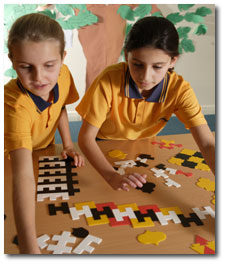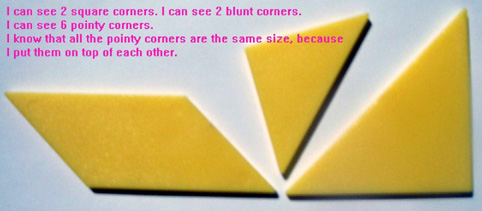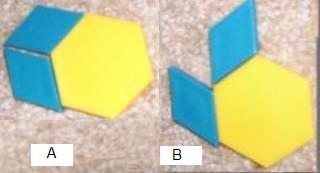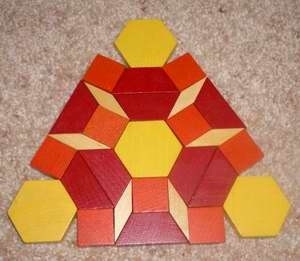Fitting Shapes Together: 2.25 - Part 1
Supporting materials
Indicator of Progress

Success depends on students further developing spatial skills and becoming aware of the features of shapes that enable them to fit together in various ways, including making tessellations. They become aware of the attribute of angle as a property of a corner of a shape, and extend their understanding of length.
The spatial skills include being able to judge which sides will fit together to make a given length, whether a shape needs to be flipped before fitting into a hole, whether two corners will fit together to make a ‘square corner’, or to match another corner.
NOTE: In terms of the three measurement phases, students are within the phase of ‘learning to measure’ for length, and the phase of ‘identifying the attribute' for angle.
Illustration 1: Identifying the attribute of angle
At this level, students are becoming aware of the attribute of angle, as a description of the corner of a shape. They do not get distracted by the lengths of the arms of an angle when looking at the size of an angle (e.g. by placing one corner on top of another to compare). They can describe their observations about corners, by comparison with ‘square corner’. Informal terminology like this can be used here instead of the ‘quarter turn’ or ‘right angle’ used by more advanced students.

Text on the image above says:
I can see 2 square corners. I can see 2 blunt corners.
I can see 6 pointy corners.
I know that all the pointy corners are the same size, because
I put them on top of each other.
Illustration 2: Spatial skills

Students need spatial skills so that they can ‘see’ how to place blocks to give a desired effect.
For example, a student wanting to make pattern B may place the blue block down in such a way that it can only make pattern A. The blue block needs to be flipped.
Illustration 3: Making and describing artistic designs

Students should enjoy creating their own beautiful patterns, and then describing their features.
The image on the right has both line symmetry and rotational symmetry. Students might say that the design looks the same when viewed from any side. It is not a tessellation, because it is not clear how the pattern might continue to cover the whole floor. Also, not all the space is filled (another requirement of a tessellation). They can observe that all the sides of all the pieces are the same length (except for the long sides of the trapezia), and this helps the pieces fit together. Along the sides, they can observe that the corner of the red piece and the white piece together make a ‘square corner’ (right angle).
Teaching Strategies and Further Resources
For Fitting Shapes Together teaching strategies and further resources, see: Part 2
